Starting watercolor painting can feel exciting and a little overwhelming, especially for beginners. With so many options and techniques to try, it can be hard to know where to start. The best way to begin is by choosing easy watercolor art ideas that let anyone practice skills and build confidence without a lot of pressure.
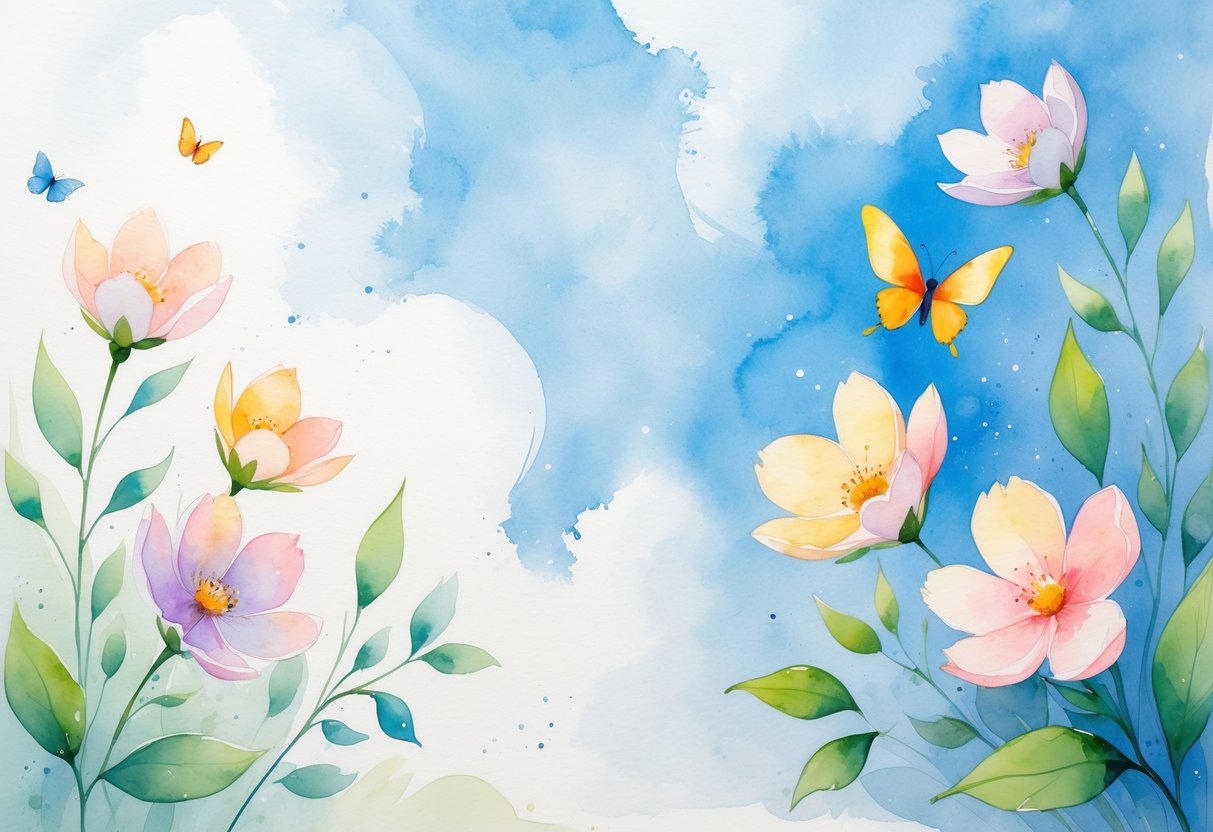
Simple projects like colorful washes, abstract shapes, or basic landscapes give artists a chance to explore the medium and see quick results. These subjects are approachable and don’t require any special training or experience.
With a few basic supplies and some inspiration, anyone can create beautiful watercolor art while having fun. These easy ideas make it simple for beginners to try new things and develop their own artistic style.
Getting Started With Easy Watercolor Art

Watercolor painting is enjoyable and relaxing for beginners if they start with the right tools, select simple color palettes, and learn a few basic techniques. Paying attention to brushes, paper, and paint quality helps make the process smoother.
Essential Watercolor Supplies
To begin watercolor painting, certain supplies are necessary. These include watercolor paints (in pans or tubes), brushes, watercolor paper, a mixing palette, clean water, and paper towels.
For beginners, three to five brushes in different shapes—such as round, flat, and detail—are enough. Watercolor paper should be at least 140 lb or 300 gsm to prevent warping. Regular paper will easily tear or buckle. A white plastic mixing palette gives good visibility for color mixing.
Other helpful items are masking tape (to keep paper flat) and a pencil for sketching simple outlines. Clean water and extra paper towels help manage mistakes and keep colors fresh.
Choosing the Right Watercolor Palette
A beginner watercolor palette should include 12 basic colors. This usually covers the primary colors—red, blue, and yellow—plus a few earth tones, like burnt sienna and ochre, and a couple of greens and blues.
Suggested basic palette:
| Color Name | Type |
|---|---|
| Cadmium Red | Primary |
| Cadmium Yellow | Primary |
| Ultramarine Blue | Primary |
| Burnt Sienna | Earth tone |
| Yellow Ochre | Earth tone |
| Sap Green | Green |
| Payne’s Grey | Neutral |
Starting with a small set of reliable colors teaches beginners how to mix and create more shades.
Using student-grade paints is fine for beginners. These paints are affordable and easy to use, although artist-grade paints give stronger color. It is best to avoid children’s watercolor sets because the colors can be weak or chalky.
Basic Watercolor Techniques for Beginners
New artists can learn several simple watercolor techniques:
- Wet-on-wet: Apply clean water to the paper, then add paint. The color spreads and blends softly.
- Wet-on-dry: Paint with a wet brush onto dry paper. This gives distinct lines and shapes.
- Color mixing: Combine two colors on a palette to see how new shades form.
- Layering (glazing): Let a layer dry, then paint another color over it for depth.
Practicing gradient washes, simple shapes, and basic patterns can help build confidence. Beginners may want to try painting small objects, like leaves or flowers, before moving to bigger scenes.
Understanding Brush Strokes and Paper Types
Brush strokes in watercolor painting create different effects. A round brush makes fine lines or wide shapes, depending on pressure. Flat brushes are ideal for broad washes or sharp edges. Beginners can practice controlling how much water is in the brush to change the texture.
Paper quality changes how paint looks and reacts. Cold press paper has a rough texture for soft, grainy effects. Hot press paper is smooth, better for clean lines. Heavier paper (140 lb/300 gsm or above) stays flat and resists buckling, even with lots of water.
Using painter’s tape keeps the paper edges neat and prevents warping. Testing small brush strokes and different papers teaches beginners how materials affect the painting results.
Creative Easy Watercolor Art Ideas for Beginners
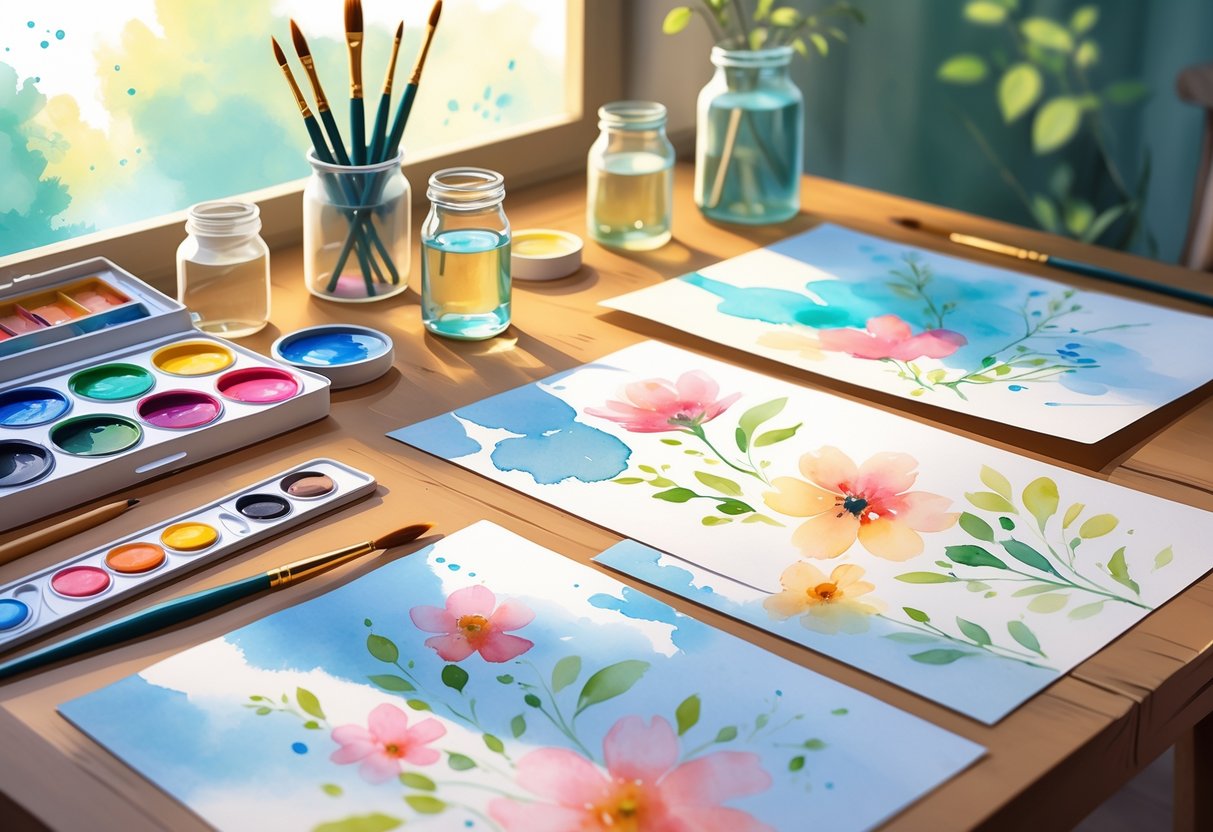
Watercolor painting is approachable and fun for beginners, with plenty of simple subjects to start with. Everyday scenes, foods, and objects work well because they offer a balance of color and shape that is easy to capture.
Simple Watercolor Flowers
Flowers are a favorite subject for easy watercolor art ideas. They allow beginners to practice blending soft colors and using gentle brushstrokes.
Basic steps for painting watercolor flowers:
- Start with a light pencil outline of the petals and stem.
- Use a wet brush to apply the lightest color first, such as pale pink or yellow.
- Let the first layer dry, then add deeper shades for shadows.
- Keep the look soft by blending edges with a clean, damp brush.
Popular watercolor flowers for beginners include tulips, daisies, poppies, and sunflowers. These flowers have basic shapes and bold colors, making them perfect for learning. Try painting a single bloom or a bunch in a small bouquet for a cute watercolor painting.
Painting Clouds and Skies
Painting clouds is one of the easiest watercolor painting ideas for beginners. This subject helps new artists practice creating gradients and blending.
A simple landscape often starts with a blue wash for the sky. While the paint is still wet, dab clean water on the page to lift out soft, cloud-like shapes. Use a tissue to gently blot for fluffy textures.
For richer skies, layer in hints of purple, yellow, or orange. Sunsets and sunrises give beginners a chance to work with color transitions. With clouds and skies, mistakes are easy to fix—just dab away excess paint or spread it for natural-looking shapes.
A well-blended sky can make even the simplest landscape painting feel lively and fresh.
Easy Mountain and Landscape Paintings
Mountains are a classic choice for easy watercolor paintings and simple landscapes. Their shapes do not require much detail and allow for expressive brushwork.
Start by painting a faint background for the sky. Then, use a darker shade to outline mountain peaks, letting the colors fade as they move down the page. Add layers for depth by painting more mountains in the background with lighter colors.
For a simple watercolor landscape, add a flat area of green for grass or blue for water at the base. Tip: Let each layer dry before adding the next to keep the colors crisp. Beginners can create striking scenes with just a few shapes and a limited palette.
Fun Fruit and Food Watercolor Art
Fruit and food offer bright colors and simple shapes, making them great for beginner watercolor painting. Lemons, apples, watermelon slices, and ice cream cones are all popular options.
Painting these items helps beginners learn about highlights and shadows. For example, paint a lemon with a round yellow shape, then use a bit of green or darker yellow to shade one side. Watermelon slices pair a red center with a green rind, which is easy to outline. Ice cream cones can include fun colors and melting scoops for a cute watercolor painting.
Fruit and food subjects can be sketched in groups or alone for a playful look. Try arranging several items on a page or make a series of small paintings using different snacks or produce.
Exploring Abstract and Nature-Inspired Watercolor Art
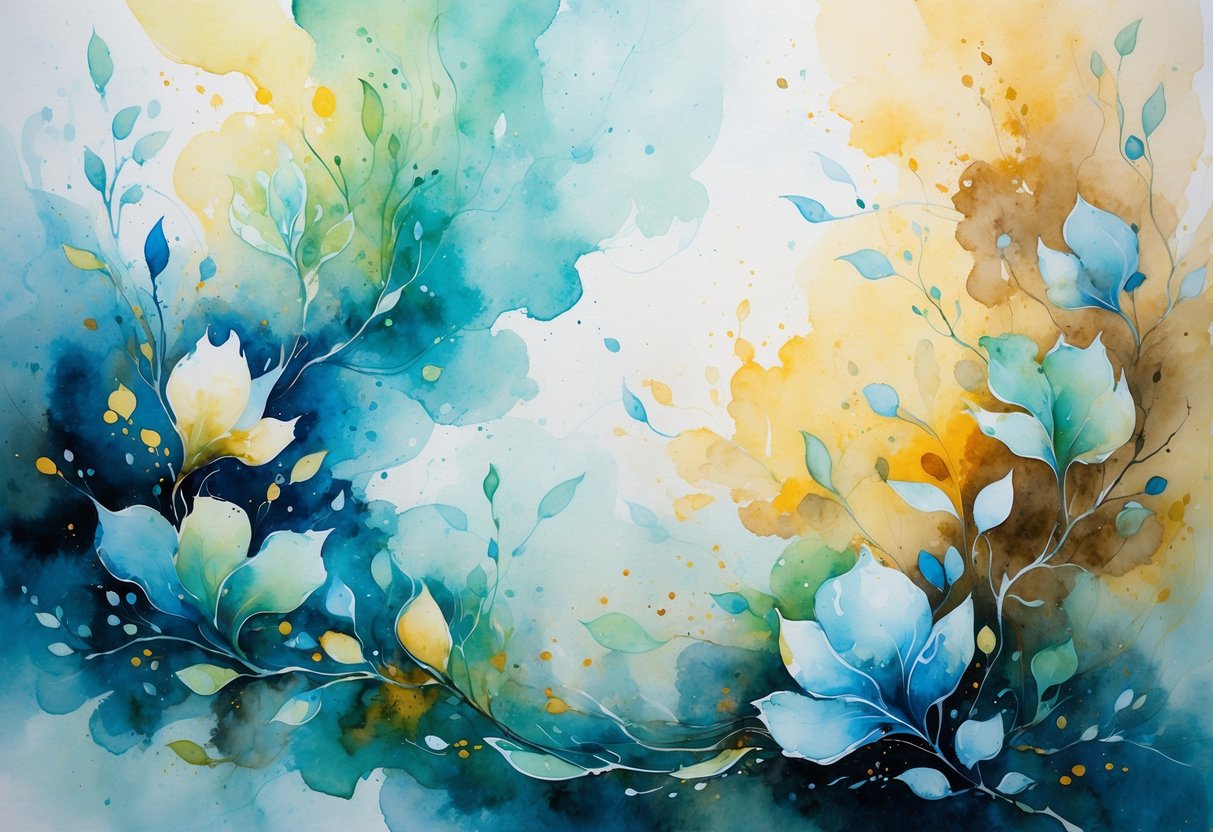
Abstract watercolor, tree painting, leaves, cactus, and pebbles are all popular themes for beginners. These subjects help artists learn important techniques, work on creativity, and develop basic skills with watercolor paints.
Abstract Watercolor Painting Techniques
Abstract watercolor painting focuses on shapes, colors, and textures rather than realistic subjects. This style helps beginners explore blending, layering, and controlling water. Simple projects can include painting lines, circles, or abstract squares using soft washes of color.
A good way to start is by experimenting with wet-on-wet and wet-on-dry approaches. Beginners often use masking tape to create straight edges or bold blocks. Mixing colors on paper can produce unique, unpredictable effects.
Some artists use salt or rubbing alcohol to create interesting patterns. These techniques highlight the playful side of watercolor. Painting without a set plan encourages creativity and helps build confidence.
Simple Abstract Watercolor Project Ideas:
| Project | Tools Needed | Technique |
|---|---|---|
| Abstract Squares | Tape, brush | Wet-on-wet |
| Color Swatches | Brush | Blending colors |
| Bold Lines | Thin brush | Layering strokes |
Forest and Tree Paintings
Forest and tree paintings let beginners practice using different brush shapes. Creating the look of leaves, trunks, and branches gives artists a chance to play with texture and color variety.
To paint a simple tree, artists start with a vertical line for the trunk and branch out using curved lines. Using more water makes soft-looking leaves, while less water creates sharper edges. Layering several greens and browns gives depth.
A forest scene can be made by painting tree outlines of different heights and shades. Letting earlier layers dry before adding new ones stops colors from mixing too much. Dabbing with a sponge or paper towel gives extra texture.
Tips:
- Use a round brush for branches.
- Make trees look far away by using lighter colors.
Cactus and Leaf Motifs
Cactus and leaf motifs are popular because their shapes are simple, but the designs can vary. Painting cacti helps artists get comfortable with green shades, smooth washes, and building up layers.
Artists sketch the basic outline of a cactus with rounded shapes. Filling the shape with light green, letting it dry, and then adding darker lines for texture creates a three-dimensional look. Small prickles can be added with a fine brush.
Leaves can be painted using one brushstroke for each leaf. Trying different types of leaves—like ferns, ovals, or pointed leaves—teaches brush control. Sometimes artists add veins or color gradients for more detail.
Try painting:
- A single aloe plant
- A branch with three different leaf shapes
Pebbles and Geometric Watercolor Elements
Painting pebbles and geometric watercolor elements lets beginners practice shading and control. Pebbles are often oval or round, with soft edges and varied colors.
Artists start by outlining each pebble shape using a light pencil. Then, each pebble is filled with a light wash, letting colors blend softly. Adding darker spots creates shadows. Overlapping pebbles can make the painting look more realistic.
Geometric watercolor shapes, such as triangles or squares, can be painted in rows or freeform layouts. These projects help artists learn to balance colors and keep edges neat by using less water or letting areas dry before adding new shapes.
Practice With:
- Pebble clusters in muted colors
- Rows of colored squares with clean edges
This variety lets beginners practice many different watercolor techniques in a fun and manageable way.
Tips, Tools, and Inspiration for Continued Learning
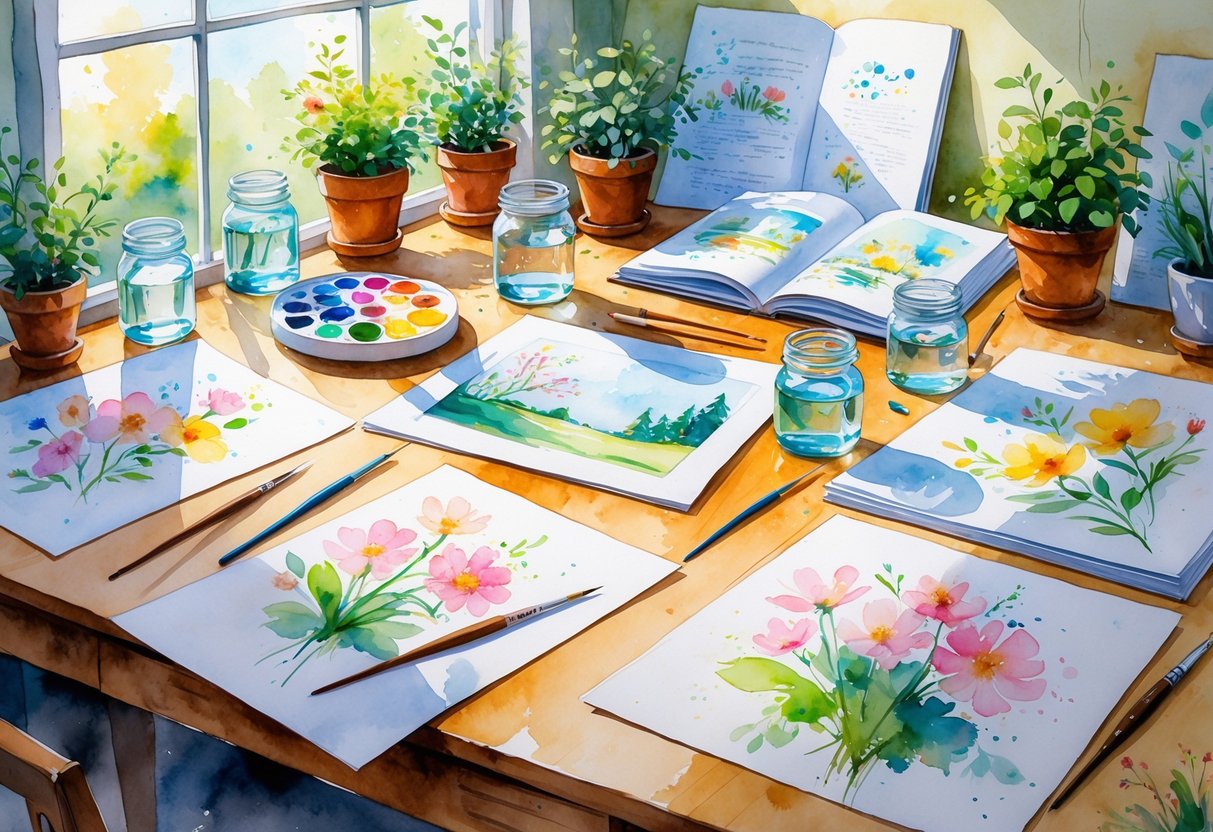
Learning watercolor art is easier when beginners have the right tools and techniques. Using the right drawing methods, tools like washi tape, creative ideas such as city skylines, and sources of inspiration will help anyone enjoy the process of painting with watercolors.
Watercolor Drawing and Pencil Techniques
Watercolor drawing starts with simple pencil sketches. Many artists use light graphite pencils or special watercolor pencils to draw basic outlines. Watercolor pencils can be used both dry, for sketching, or wet, to add depth and detail as they blend when water is applied.
It’s important to keep pencil lines light because heavy marks can show through the paint. Beginners can try blending pencil lines with a kneaded eraser before painting.
Common pencil techniques include hatching, cross-hatching, and outlining shapes. These techniques help create shadows and structure before adding washes of color. Wet-on-wet and wet-on-dry are two basic approaches; wet-on-wet gives softer edges, while wet-on-dry creates sharper lines.
Practicing these methods builds confidence and makes the painting process smoother.
Using Washi Tape and Templates
Washi tape is a handy tool for creating clean, crisp edges and fun patterns. Artists often use it to frame paintings, section off areas, or form geometric shapes before applying paint. After the paint dries, peeling off the tape reveals sharp borders that look professional.
Watercolor templates are also useful, especially for beginners. Templates guide the placement of objects and big shapes, helping users keep proportions correct. Many artists find templates online or make their own with stencils and tracing paper.
Washi tape can protect areas of the paper from color or help create special effects like stripes and grids. Experimenting with tape and templates can prevent mistakes and lead to interesting results, especially in abstract and modern designs.
Creating City Skylines and Urban Scenes
Painting a city skyline is a popular and rewarding idea for watercolor beginners. Start by drawing a simple outline of the skyline or some buildings using a pencil or a template. Focus on basic shapes, such as rectangles and triangles, to capture the forms of skyscrapers, rooftops, and bridges.
Try using the wet-on-wet technique for soft sky backgrounds, then add buildings with the wet-on-dry approach for clear edges. Layering washes can create a sunrise or sunset effect behind the skyline.
Urban scenes let beginners play with contrast, shadows, and perspective. A limited color palette will keep things simple as you build up the city in layers. Add small details like windows or lampposts with a thin brush or watercolor pencil.
Finding Watercolor Painting Inspiration
Inspiration is key to continued learning and enjoyment. Many artists look to nature, everyday objects, or online watercolor tutorials for fresh ideas. Social media platforms and art blogs regularly feature finished works, step-by-step guides, and new approaches to painting with watercolors.
Keeping a sketchbook or mood board helps track creative ideas and color schemes. Visiting art galleries, browsing photo references, or joining painting challenges are other good ways to find watercolor painting inspiration.
Online groups and watercolor communities can offer painting tips, encouragement, and feedback. Following skilled watercolorists helps learners discover new styles and techniques to try in their own work.
Frequently Asked Questions
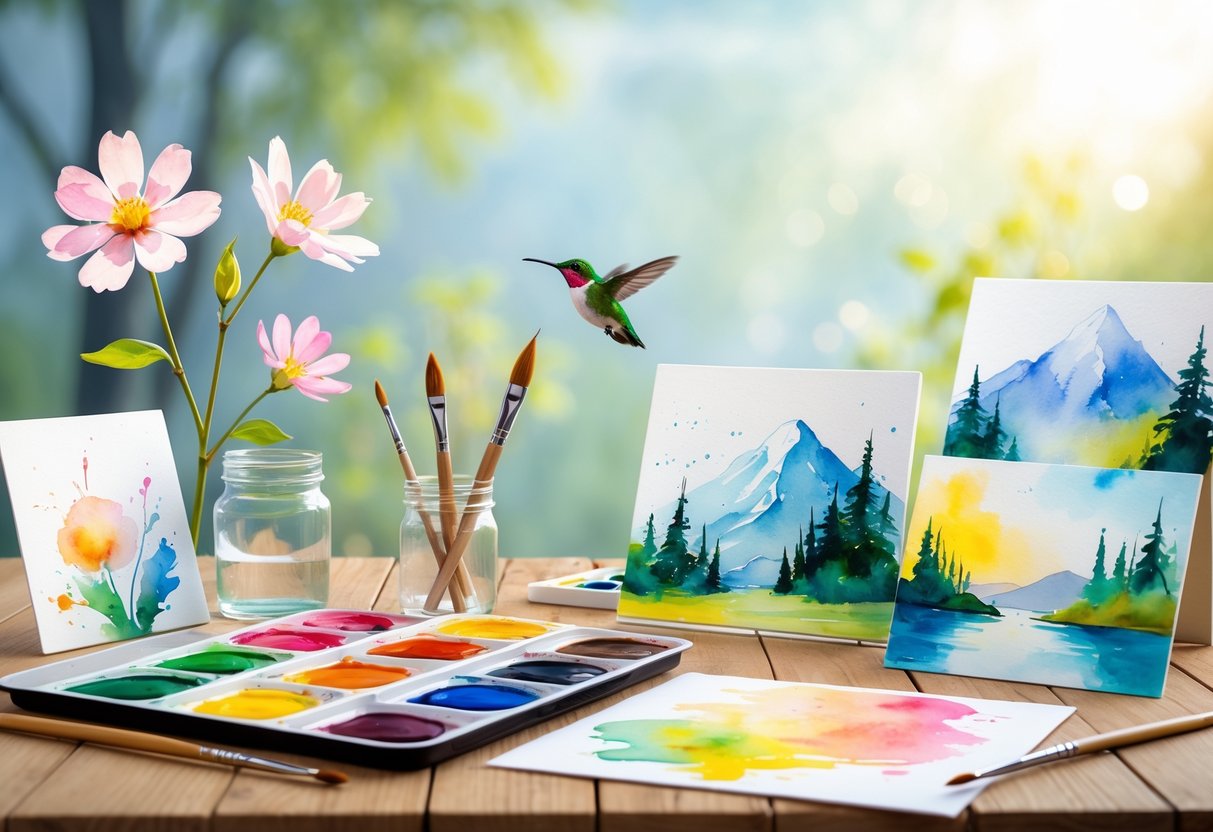
Watercolor beginners often want to know about basic techniques, simple project ideas, recommended materials, subject suggestions, and helpful tips for mixing colors. Clear steps and the right tools make starting out much easier.
What basic techniques should I learn for starting watercolor art?
The most important techniques to learn first are the wet-on-wet and wet-on-dry methods. Beginners benefit from practicing washes, gradients, and basic color blending. It also helps to explore layering colors and controlling water to paint light or dark areas.
Can you suggest simple subjects suitable for creating small watercolor paintings?
Easy subjects for beginners include leaves, simple flowers, colorful fruit, and basic landscapes like sunsets or hills. Painting items such as cups, trees, and clouds lets beginners practice shapes and washes without needing complex details. Abstract shapes and patterns can also be good starting points.
What are some step-by-step watercolor projects for a beginner to follow?
Many beginners enjoy painting a single flower petal by petal, a sky with a simple gradient, or a tree with layers of green. Some projects include painting small cacti, fruit slices, and basic night skies with light stars. Step-by-step guides often start with drawing a light pencil outline and moving from light washes to darker details.
How do I choose the right watercolor materials as a beginner?
Beginners should look for a small set of student-grade watercolor paints and a few brushes in round and flat shapes. Watercolor paper labeled at least 140 lb is best because it handles water well. A simple palette for mixing, some paper towels, and two clean water jars are essential for getting started.
What are some creative watercolor ideas for adult beginners?
Adults may enjoy painting simple city skylines, landscapes with soft washes, or experimenting with abstract color patterns. Watercolor bookmarks, greeting cards, and basic animal shapes are also good practice projects. Doodling with random color spots and turning them into small scenes or flowers encourages creativity.
How can I learn to mix watercolors effectively when starting out?
Start by learning how red, blue, and yellow mix to make secondary colors like green and purple. Testing colors on a scrap of paper helps see how they will look when dry. Beginners can try mixing two colors in different amounts to get soft or bold shades and practice making color charts for reference.
